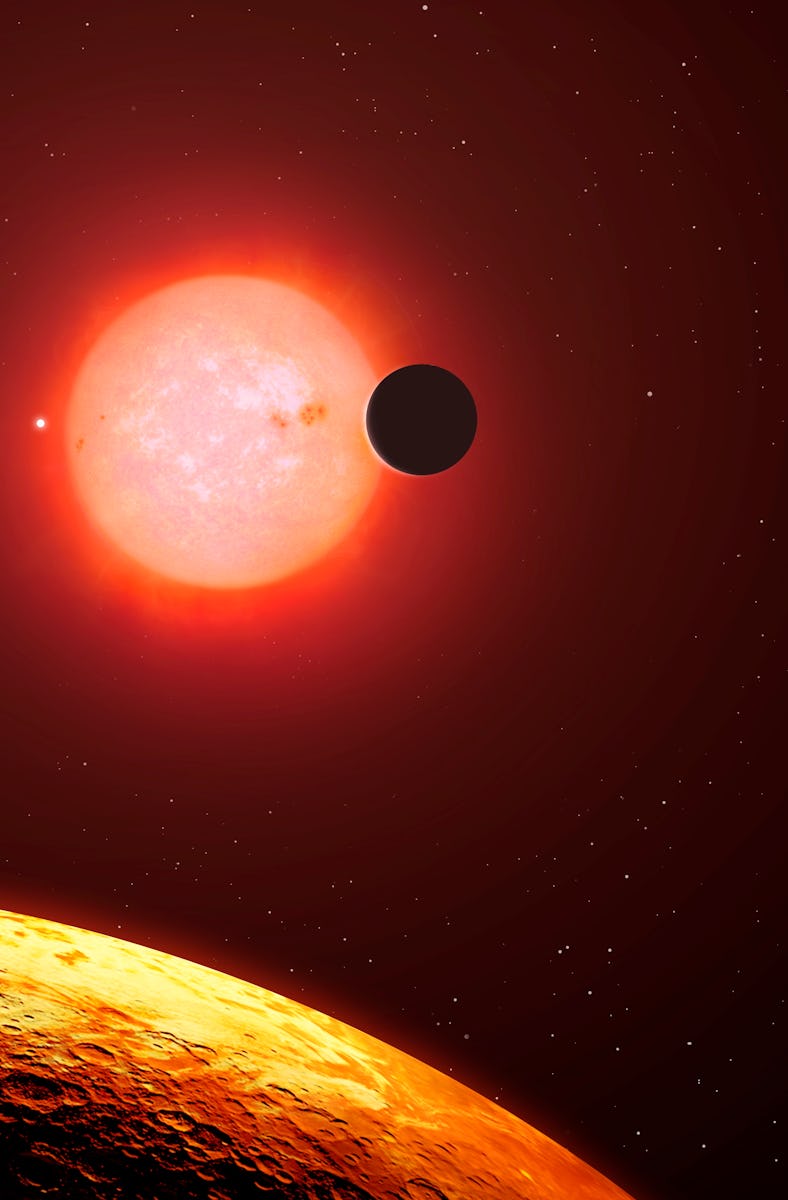New Study Might Renew Hope for Alien Life in a Once-Promising Star System
A recent study suggests that a thin, mostly-oxygen atmosphere could still fit recent JWST observations.

The discovery of the TRAPPIST-1 system stirred up excitement about a star system with three potentially habitable worlds, but recent observations of the innermost two planets have had discouraging results.
But in a recent study, University of Washington astrobiologist Andrew Lincowski and his colleagues used a computer to simulate a few types of atmospheres that might fit the telescope data, and it turns out there may be a little bit of air there, after all. Lincowski and his colleagues say there’s an even chance that TRAPPIST-1c, the system’s second-innermost planet, is either a bare rock or has a thin atmosphere. That could be good news for the chances of life on planets farther out in the system.
The researchers shared their work in a recent preprint paper, which has not yet been peer-reviewed.
This image shows the star TRAPPIST-1 and six of the planets as they would appear from the surface of the fifth outermost planet, Trappist-1f.
TRAPPIST-1c: Air or Bare?
Recent JWST observations of the two innermost TRAPPIST-1 planets suggest that neither world has an atmosphere thick enough to carry heat from the tidally locked planets’ scorched daylit side to the cooler night side. In the last few months, two teams of astronomers have used JWST to watch each planet pass behind TRAPPIST-1, offering a brief glimpse of the daylit side, which usually faces toward the star and away from Earth. Astronomers call this a secondary eclipse, and they use it to measure whether the hottest point on a planet is directly beneath the star, or whether heat seems to be flowing across the planet’s surface; the second option is a good sign that a planet has a thick, circulating atmosphere to move heat around.
Lincowski and his colleagues recently used a computer to simulate what TRAPPIST-1c’s secondary eclipse might have looked like with several different atmospheres of different densities and chemical makeups. The researchers then compared their simulation results to the actual JWST data, to see whether a planet with any kind of atmosphere could have produced the discouraging secondary eclipse results JWST saw. It turned out that the secondary eclipse data could be explained not only by a bare, star-scorched rock, but also by a handful of relatively thin, low-pressure atmospheres.
“There has been a quick leap to ‘no atmospheres’ by many, but the reality is that there is still plenty of atmospheric scenarios that match our current observations,” Cornell University astronomer Nikole Lewis, who commented on the study but was not involved, tells Inverse.
The most likely possibilities from Lincowski and his colleagues’ simulations all had about one-tenth the atmospheric pressure we feel at sea level here on Earth. When the researchers modeled thin atmospheres of pure oxygen, a mix of oxygen and water vapor, or oxygen with a dash of carbon dioxide (a dash is about 100 parts per million, for our purposes), all of their computer-simulated secondary eclipses looked very similar to the one JWST actually observed.
The simulations suggested a small chance that TRAPPIST-1c could have an atmosphere slightly denser than Earth's, with a heftier dose of carbon dioxide in the mix, although that’s much less likely than the other scenarios. And of course, it’s still just as likely as not that TRAPPIST-1c and its nearest neighbor are airless rocks after all.
“At the current level of data, a bare rock is just as likely as a thin atmosphere,” says Lincowski. “Additional observations are forthcoming that may help constrain that.”
Three of the seven TRAPPIST-1 planets are in the habitable zone.
A Good Sign for Life in the Habitable Zone
Even if the innermost TRAPPIST-1 worlds turn out to have atmospheres, it still won’t mean they’re habitable; they’d be much too hot for liquid water to exist on their surfaces. Imagine trying to make a living on Mercury or Venus, and you’ve got the general idea. But if two planets so close to a temperamental red dwarf star and its frequent stellar flares can hold onto thin atmospheres, then planets farther from the star, in the habitable zone, might have an even better shot at offering alien life some actual air to breathe.
“This is a great indicator for the possibility of retaining volatiles, and therefore an atmosphere, in the other planets,” says Lincowski.
Ultimately, of course, the best way to find out for sure whether any planet really has an atmosphere is to gather more data with high-resolution telescopes like JWST. In the coming year, a team of astronomers, which includes Lincowski, will take another look at TRAPPIST-1b and -1c in hopes of measuring how temperature changes between the dayside and the nightside of each planet. And a team of astronomers led by Lewis will measure the spectrum of light emitted from TRAPPIST-1e, one of the system’s potentially habitable worlds. If the planet has an atmosphere, its spectrum should include the signatures of chemicals like oxygen, carbon dioxide, water vapor, or even methane.
Astrophysicist Thomas Greene, whose team carried out the observations of TRAPPIST-1b and who is also included in the upcoming TRAPPIST-1b and -1c observations, tells Inverse that in addition to Lewis’s planned spectroscopy, he would like JWST to observe a secondary eclipse of TRAPPIST-1e. “This would be using the same technique recently used for TRAPPIST-1b and -1c, but it would take much more observing time (100 – 400+ hours) since the planet should be much colder than TRAPPIST-1b or -1c.”